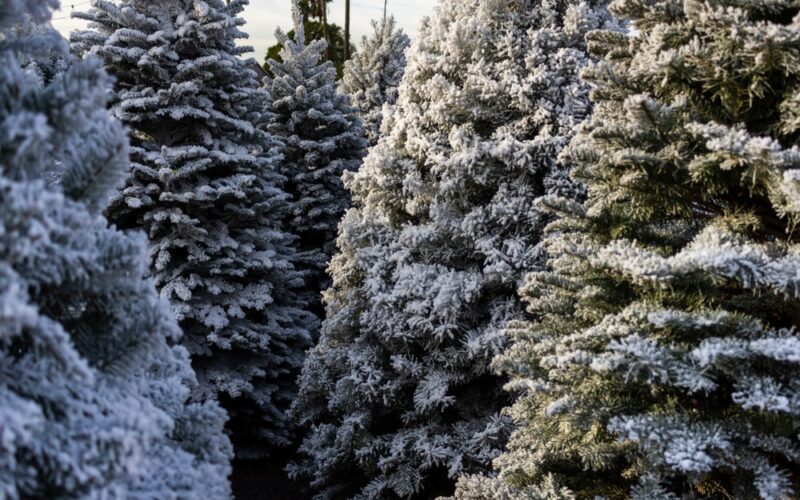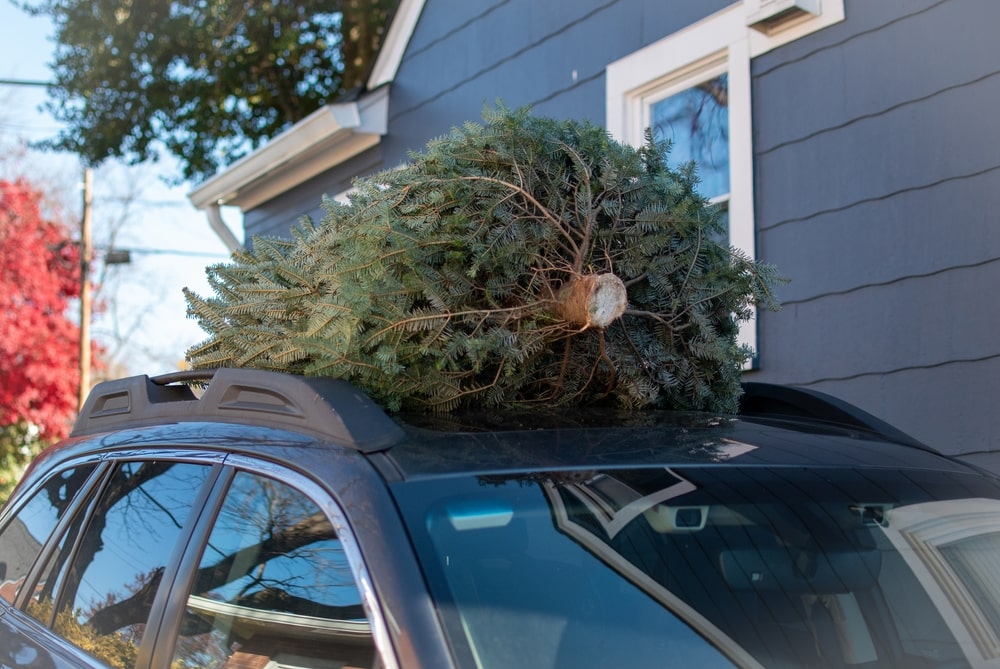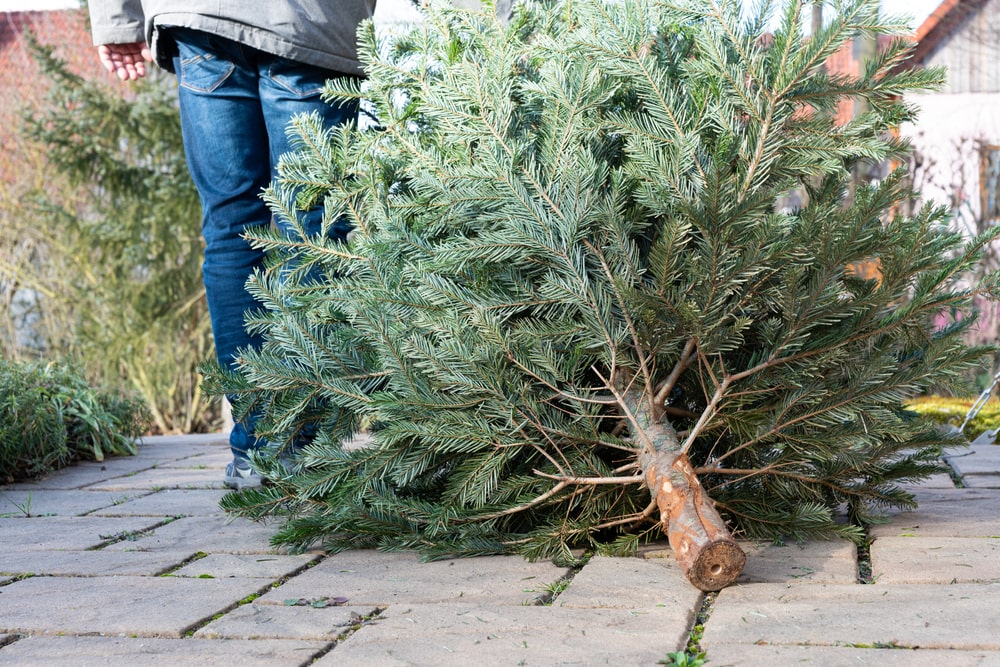Christmas Tree Care: How To Make Your Tree Last

If you’ve decided to purchase a fresh-cut Christmas tree this year, you may be eager to cut your tree and bring it home. But, if you cut your tree too early, you may struggle to keep it fresh and green until Christmas or the new year.
For a tree that thrives all December long, check out our tips for proper Christmas tree care and how to make yours last.
How Long Do Christmas Trees Last?
While many people start decorating on November 1st, even the freshest-cut trees aren’t made to last forever. A healthy, fresh-cut Christmas tree will last for four to five weeks if properly cared for. Even then, the lifespan of your tree may depend on what species you choose to put up.
Signs that your tree may be on its last legs include needles becoming brittle and falling off the tree in large numbers, and the branches start drooping (which you may notice if your ornaments are weighing them down more, or completely falling off the branches, so keep an eye on your fragile ones).
If you’re itching to put up your holiday decorations earlier, start with non-living decorations whenever you like, and finish off with fresh greenery and your Christmas tree around the first of December.
Picking Out a Christmas Tree
In order to have a green tree all December long, you’ll need to pay attention to a few things when selecting your tree. Starting with a healthy tree is a huge part of how to make a Christmas tree last.
Species
There are a variety of tree species to choose from when it comes to selecting a Christmas tree. While most of them will last about a month, there are a few that stand out for their excellent needle retention:
- Fraser Fir
- Concolor (White) Fir
- Douglas Fir
- White Pine
Health
While it may seem like common sense, you should pick out a tree that looks physically healthy. These trees are more likely to last you through the holidays, and can be identified by a few simple traits:
- Soft, pliable outer branches
- Even color across branches and needles
- A fresh, fragrant scent
- Bark that is smooth, not wrinkled
Transport and Store Your Tree Safely
Once you’ve selected a gorgeous, healthy tree for your home, you’ll need to have a plan for how to get it home safely.
At Stauffers, we’ll gladly assist you with wrapping and loading your tree into your vehicle for free. Whether you choose to strap it to a roof rack or fit it inside your vehicle, we’ll be there to help.
Here are a couple of tips to keep in mind when prepping to put your Christmas tree on the roof of your car:
1. Weather
Try your best to pick up your freshly-cut tree on a clear day.
While Christmas trees can endure the cold just fine, rain and snow can create less-than-ideal conditions when traveling with a Christmas tree on the roof of your car. Not to mention bringing a wet tree inside the house can make the process a bit more messy than memorable.
2. Transportation
When customers ask us how to make a Christmas tree last longer, transportation is the first thing we mention. Being too rough with your tree can cause it to drop needles prematurely, making a mess and leaving bare spots in its greenery.
Most trees come packaged in netting, which helps keep their more delicate branches safe on the trip. If your tree does not come wrapped up, consider wrapping it in an old blanket to keep it safe and confined.
If you’re transporting your tree on the roof, put the trunk end at the front of the vehicle. This will prevent needles from blowing off.
3. Storage
Many people like to store their tree outside or in a garage for a few days before bringing it in. If you plan on storing your tree outside, stand it up in a bucket of water in the shade to keep it hydrated. You can also bring it inside into a garage or shed for extra protection.
But don’t wait too long, especially with fresh-cut trees. As you will learn further down, proper Christmas tree care requires a heavy amount of watering the first few days it is brought home.
Best Christmas Tree Stands
Getting your Christmas tree straight and in its stand can be one of the more stressful parts of Christmas.
Here are a few tips for getting your tree ready for ornaments, while also ensuring longevity of its color and form.
Make a Fresh Cut
Many home and garden centers will make a fresh cut for you before you take your tree home. If you are unsure, feel free to ask the tree sellers if they do, and what size they will make the hole so you can figure out the best Christmas tree stand to use.
If you choose to do it yourself instead, start by cutting between half an inch and one inch off the bottom of your tree’s trunk. Making an even cut now will make getting your tree in the stand even easier.
Drilling a Hole
While some tree stands require drilling a hole in a Christmas tree’s trunk to center it on its base, there is no need to drill a hole for water consumption.
We recommend having a professional be the one to drill the hole. However, if you find that you want to do this yourself, we recommend:
- Picking a spacious outdoor location (for easy clean-up)
- Laying the tree on its side and securing it so it will not move or roll away
- Drilling a 1-2 inch diameter hole in the bottom center of the trunk around 2-4 inches deep
Stauffers Home & Garden stores offer both cutting and drilling services at no charge when you purchase a fresh-cut tree. Additionally, we will bag and load your tree.
How To Keep a Christmas Tree Alive
For those who like to decorate early, keeping your tree fresh and green throughout the holiday season is crucial. Once cut, Christmas trees will slowly begin to wilt and lose their bright green color.
With these easy tips, you can keep your Christmas tree looking beautiful from Thanksgiving to New Year’s.
Watering Your Christmas Tree
If you’re wondering how to make a Christmas tree last as long as possible, the simple answer is water.
But how often do you water a Christmas tree? The answer: every day.
For at least the first two weeks after being cut, water and refill your tree stand every day. This is when trees take up the most water.
While trees can drink up to a gallon of cool water per day, the general rule is that they will drink one quart for every inch of trunk diameter. For example, a tree with a trunk that is three inches across at the base would need three quarts of water per day.
When in doubt, check the water of your tree stand every day. If you notice the water levels are below the bottom of the trunk or that the bowl housing the tree is nearly empty, go for a refill. Once the water stops drastically decreasing daily, you can space out the watering as necessary.
Wilt-Stop
Wilt-Stop is a plant-protecting spray that can help your Christmas greenery keep its color throughout the holiday season. It prevents your tree from losing moisture by creating a protective coating over its needles. This will keep your tree looking fresh and also prevent it from dropping needles prematurely.
Wilt-Stop is made from the resin of pine trees, which means that it is a great, non-toxic way to make Christmas trees last longer. In addition to using Wilt-Stop on your Christmas tree, you can use it for any other holiday greenery around your home, from wreaths to garlands.
Avoiding Sources of Heat
Because Christmas trees are still prone to drying out, it’s best to avoid setting yours up around heat sources such as fireplaces, furnaces, and lit candles. It’s recommended to set the tree up in a space with no hazards nearby.
The same caution goes with leaving Christmas lights on that have been lit for extended periods. Sometimes, larger light bulbs can heat up quickly, either leading to premature drying or accidents, so either remember to turn your lights off when you’re not using them, or stick to smaller bulbs.
Christmas Tree Maintenance
Now that your tree is all set up, decorated, and ready to brighten your living room, you may think that the care ends there. However, because your Christmas tree is still a living plant, it will still need some additional care.
Needles and Shedding
You may notice after a bit your Christmas tree needles falling off and scattering all over your floor.
Typically, this is a sign your Christmas tree is dry and in need of water. So, as mentioned above, check your tree stand’s water bowl and refill it enough so a good majority of the base is covered.
Also, as mentioned before, move your tree away from any heat sources you suspect may be negatively affecting its health. Keeping the area it is placed in at a cool temperature will help prevent the tree from losing too much moisture from excessively warm air as well.
Christmas Tree Pests/Insects
Sometimes, certain insects may remain dormant, hidden in trees until they are exposed to a warm source/environment. Virtually, none of these pests are harmful, but can be annoying to deal with, especially if you don’t want them in the home.
Here are a few bugs to keep in mind should you stumble upon them hanging around the trunk or branches of your tree:
- Adelgids
- Aphids
- Bark beetles
- Mites
- Spotted Lanternflies
- Praying Mantises
Christmas Tree Disposal and Recycling
While many counties and municipalities have Christmas tree pick-up services, there are several ways to reuse and recycle your Christmas tree in the new year. With these tips, you can make your Christmas tree last even longer.
When to Dispose of Your Christmas Tree
You don’t have to worry about taking down your tree right after Christmas. If you have been attentive in your Christmas tree care, then there is a high chance of your tree lasting into the first few weeks of January.
Drooping branches and needles that have become brittle and are shedding at a faster rate than normal despite your attentive watering are all indicators of the tree being ready to be taken.
Shelter For Backyard Wildlife
Give winter birds, chipmunks, and other backyard creatures a little extra shelter from the cold this winter by taking your Christmas tree outside once you’re done with it. You can lean it up against a fence or another tree, or lay it on its side to provide a home for rabbits and other animals.
Just make sure to place it away from your house to prevent any animals from trying to join you in your heated home.
Turn Your Tree Into Mulch
If you have a garden, you can use your Christmas tree to keep the roots of your perennials warm over the cold months. There are two ways to utilize branches as mulch, and neither requires a wood chipper or shredder.
To protect perennials, you can simply clip a few small branches from the tree and lay them on top of the soil around your plants. This will keep the roots warm all winter long.
You can use pine needles to help protect your plants and keep moisture in your soil. Simply cut a branch off and shake or wipe the needles off. If they don’t fall off easily, give your tree another day outside without water.
Now that you know how to make a Christmas tree last, are you ready to buy? Explore our wide selection of artificial, fresh-cut, and living Christmas trees at Stauffers today!
This blog was originally published on November 21, 2019. It was updated December 14, 2023.



